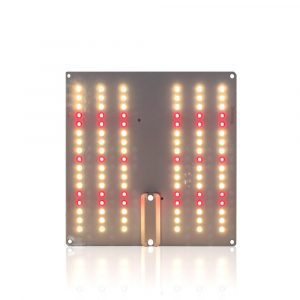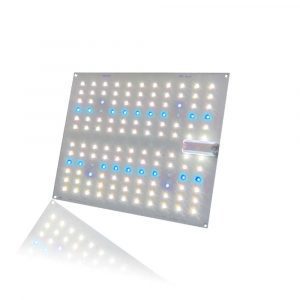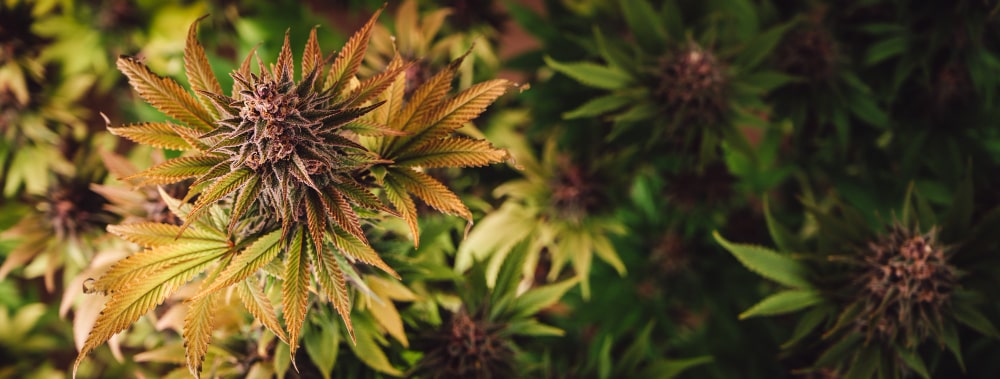For most growers, flowering is the most exciting time of the grow! All the work of growing cannabis finally becomes visible and shows in resinous buds. Nevertheless, flowering is a phase in the life cycle of your cannabis plant that requires special attention. The hemp flowering phase not only marks the transition of your plant from the vegetative stage to the production of buds, but is also crucial for a high-yielding harvest.
In this blog post, we will explain what exactly the hemp flowering phase is and how to recognize that hemp is in the flowering stage. We will also look at the special care requirements of hemp plants during this phase and give you valuable tips for flowering.
If you have a Bonsanto grow box, we recommend that you follow our Bonsanto cultivation guide. There you will learn how to grow in our grow boxes. Since all Bonsanto grow components are perfectly matched to each other and thus provide you with an ideal grow environment for your hemp, you can completely dispense with the use of measuring devices when growing with Bonsanto!
Inhaltsverzeichnis
What is the flowering phase?
The flowering phase of hemp refers to the period in the growth cycle of the hemp plant during which the plant forms flowers. This phase follows the vegetative growth phase and takes place before the harvest. Flowering is a crucial phase for growers, as the highest concentrations of therapeutically active substances, such as cannabinoids, tetrahydrocannabinol (THC) and cannabidiol (CBD), are found in the emerging flowers.
Instead of concentrating on the formation of leaves and stems, cannabis puts its energy into the production of flowers during the flowering phase. In addition to the production of flowers, the formation of resinous trichome glands also takes place. The flowering phase of cannabis usually begins when the daylight hours are reduced (approximately to 12 hours of light and 12 hours of darkness).
You should know that a distinction is made between female and male cannabis plants and that only the female plants produce the so-called buds.

When does the hemp flowering phase begin?
When the flowering phase of your cannabis plant begins depends on whether you are cultivating indoors or outdoors. For outdoor cultivation, hemp enters the flowering stage when the days become shorter, such as in the fall. In indoor cultivation, you can deliberately induce your plant to flower by reducing the lighting from approximately 18 hours to 12 hours of light per day, as mentioned earlier. An exception is autoflowers. These hemp plants enter the flowering stage automatically, regardless of the hours of daylight.
How to identify the flowering phase of hemp?
The flowering phase of hemp can be identified by various signs. The first indication of the beginning of the flowering phase is the so-called pre-flowers. These small, hair-like structures appear at the nodes of the plant where the main stems meet branches. In female plants, these pre-flowers resemble tiny, hairy buds, often with one or two white hairs known as pistils. In male plants, they are more spherical and do not contain hairs.
A clear sign of the flowering phase is the pistils, which are white or cream-colored and protrude from the pre-flowers. These pistils are part of the female reproductive organ and capture pollen from male plants. During the flowering phase, they can change their color from white to brown or red.
After the development of the pistils, the actual formation of your plants’ flowers begins. The pre-flowers become larger and denser, transforming into cannabis flowers or “buds.” These buds are often sticky and aromatic due to the resin containing cannabinoids and terpenes.
Additionally, the vertical growth of your plant significantly slows down during flowering as energy is concentrated on flower formation.
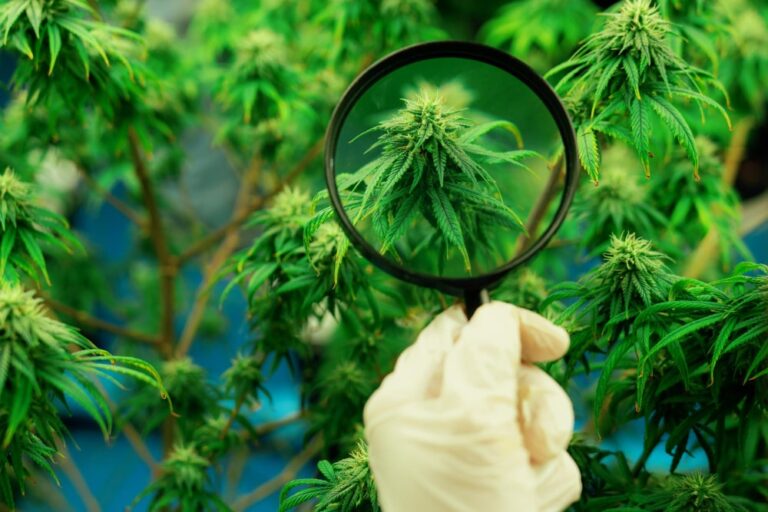
How long does the flowering phase of hemp last?
The duration of the flowering phase can vary depending on the variety and environmental conditions. In general, however, the flowering phase lasts between 5 and 10 weeks.
You should note that indica-dominant cannabis strains tend to have a shorter flowering time, while sativa-dominant strains are in bloom for longer. As mentioned above, environmental factors also play a role. Hemp plants that you grow in ideal conditions will flower faster, while factors such as poor lighting, temperature fluctuations, nutrient deficiencies or disease can extend the flowering time.
You can determine when the flowering phase of your hemp plant is over and you should start harvesting by the color of the trichomes and resin glands on the flowers.
Translated with DeepL.com (free version)
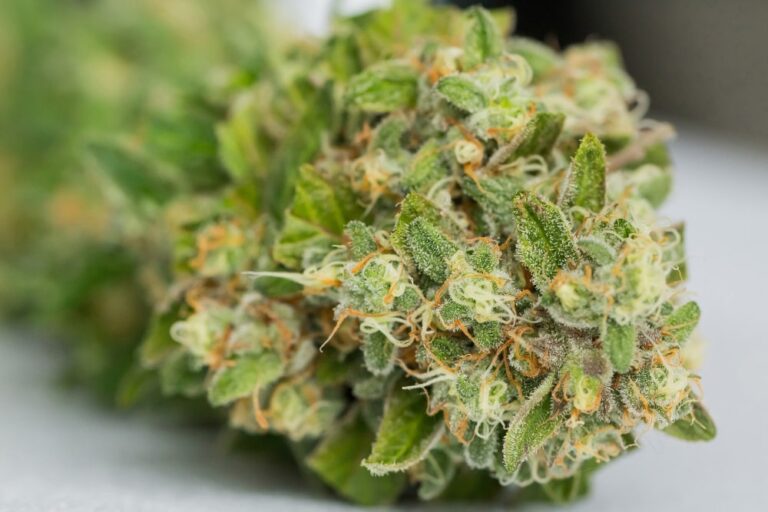
When does the hemp flowering phase end?
The flowering phase of your cannabis ends when your plant is ready for harvest. The resin glands or trichomes of your plant are the indicator of when harvesting can take place. Use a magnifying glass to check if the trichomes have already taken on a milky and amber appearance – this is the signal to harvest! When about 80% of the trichomes have an amber color, you can start harvesting. The white hairs (pistils) on the buds also indicate the time of harvest by turning brown and retracting. Harvesting should begin as soon as around 40-75% of the pistils have turned a brownish color.
You can find out more about harvesting in our article “Harvesting hemp – instructions & tips”.
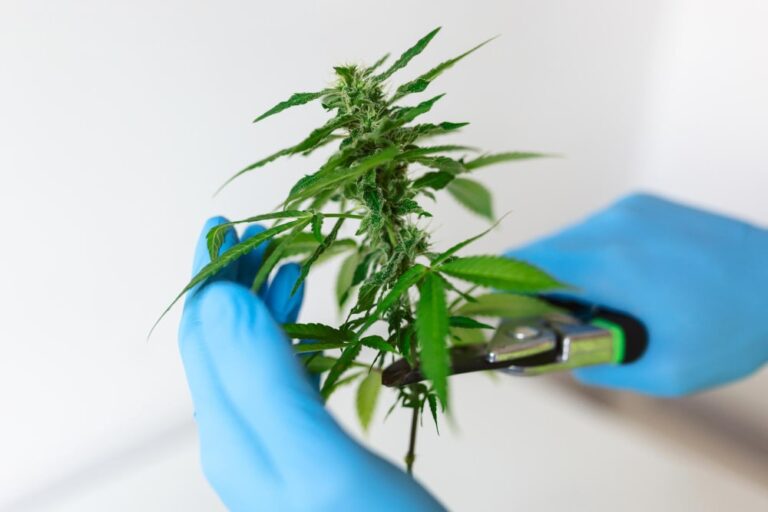
The right care for hemp in the flowering phase
You can find out below what the optimum grow environment for your cannabis plant should look like during the flowering phase. We would like to remind you once again that if you are growing in a Bonsanto grow box, the Bonsanto “Growing instructions” are relevant for you. There you will find everything you need to know for a successful grow in a Bonsanto grow box.
How much nutrients does hemp need in the flowering phase?
In the flowering phase, the nutrient and water requirements of your cannabis plant change compared to the previous growth or vegetative phase. During this time, your plant focuses on producing flowers, which requires a change in the nutrient composition.
In general, the hemp plant requires less nitrogen (N) during the flowering phase. Phosphorus (P) and potassium (K) are the substances your plant benefits from the most during flowering. A commonly recommended NPK ratio (nitrogen, phosphorus, potassium) for the flowering phase is 1:3:2, although this can vary depending on the strain and specific nutrient program. We recommend that you primarily follow the fertilizer manufacturer’s dosing instructions. Be careful not to give your plant too many nutrients during flowering to avoid nutrient burn and stop fertilizing when your plant is approaching harvest.
How much water does hemp need in the flowering phase?
A cannabis plant’s water intake can increase during the flowering phase as the plant grows and its leaves and flowers require more moisture. However, the exact amount of water a plant needs depends on many factors, such as the size of the plant, the environmental conditions and the type of grow medium the plant is growing in.
A good rule of thumb is to water the plants thoroughly and then wait until the top inch of soil is dry before watering again. Overwatering can lead to problems such as root rot and should therefore be avoided at all costs.
What is the ideal humidity in the flowering phase?
As excessive humidity can lead to mold and fungi, you should ensure that the humidity in your grow room is correct, even during the flowering phase. The optimum humidity for hemp plants during the flowering phase is between 40-50%. Some growers even lower the humidity to around 30-40% in the last few weeks before harvest to reduce the risk of mold and fungal infestation.
Especially during the flowering phase, it is important to avoid excessive humidity, as the plants become bushier than in the previous phases and mold and other diseases can spread more quickly.
How lighting in the flowering phase?
In the flowering phase, growers usually use an exposure of 12 hours of light and 12 hours of darkness per day. This 12/12 light cycle mimics the natural conditions of fall, when the days get shorter. This change signals to the cannabis plant that it is time to start producing flowers.
For the flowering phase and the entire indoor grow process, we recommend using an LED grow light. LEDs have the highest energy efficiency and longest lifespan compared to other lamps and emit less heat, which protects your cannabis from burns.
While cannabis prefers a light with a higher blue component in the growth phase, it needs a higher red component in the flowering phase. To avoid annoying lamp changes, it is advisable to use a full-spectrum plant lamp that you can use for all phases of your plant. If you are looking for an LED full spectrum plant lamp, take a look at our Bonsanto grow lamps.
Do you need a full spectrum lamp?
Then discover our Bonsanto LED lamps now.
Flowering phase hemp - tips
- Send your hemp plant into flowering by adjusting the lighting cycle (12 hours of light/12 hours of darkness).
- Use a full-spectrum LED lamp throughout the entire growth cycle, providing your plant with reddish light during flowering.
- Maintain a humidity level of approximately 40-50% in your grow box.
- Fertilize your plant gently during flowering, following the dosage instructions of the fertilizer manufacturer.
- Avoid giving nutrients to your plant in the last weeks before harvest.
- Utilize a Bonsanto grow box to simplify the cultivation of your plant and to properly care for it during flowering.
